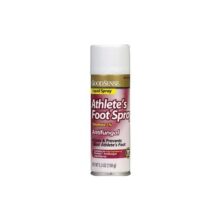Athlete’s Foot Spray
Login For Dealer Pricing
Goodsense Athlete’s Foot Spray is an antifungal spray that is designed to be effective in the treatment of most cases of athlete’s foot or ringworm.

Athlete’s foot, also known as tinea pedis, is a fungal infection that primarily affects the skin of the feet. It can affect the skin between the toes, the lateral aspect, the sole or the arch of the foot. The interdigital (between the toes) form is the most common one and it usually affects the lateral (outer) toe web spaces first.
While it might not seem as serious as some other sports-related injuries or conditions, athlete’s foot holds significant importance in the field of sports medicine for several reasons:
In summary, although athlete’s foot is not usually a life-threatening condition, it can significantly impact athletes’ performance, lead to discomfort and complications, and pose a risk of transmission in sports settings. Sports medicine professionals play a vital role in its prevention, early detection, treatment and management to support athletes in their pursuit of peak performance and overall health.
Athlete’s foot, also known as tinea pedis, is a common fungal infection that affects the skin of the feet, primarily between the toes. It can cause discomfort and itching. Here’s a breakdown of the symptoms, causes, and treatment of athlete’s foot:
Athlete’s foot is primarily caused by various types of fungi, particularly dermatophytes. These fungi thrive in warm and humid environments, such as those found inside shoes and socks. The most common risk factors and causes include:
The treatment of athlete’s foot typically involves over-the-counter or prescription antifungal medications. Here are some common treatment options:
It is important to continue treatment for the full recommended duration, even if symptoms improve, to ensure the fungus is completely eradicated. If the infection does not respond to over-the-counter treatments or worsens, consult a healthcare professional for further evaluation and treatment options. The doctor will consider the need to send skin samples for microscopy and culture. Occasionally, for example when the diagnosis is uncertain or the treatment prescribed by the family practice doctor is unsuccessful, referral to a dermatology specialist should be arranged.
In general, after successful treatment of the infection, preventive measures should be taken to reduce the risk of reinfection and good foot hygiene practiced to maintain healthy feet.

Login For Dealer Pricing
Goodsense Athlete’s Foot Spray is an antifungal spray that is designed to be effective in the treatment of most cases of athlete’s foot or ringworm.